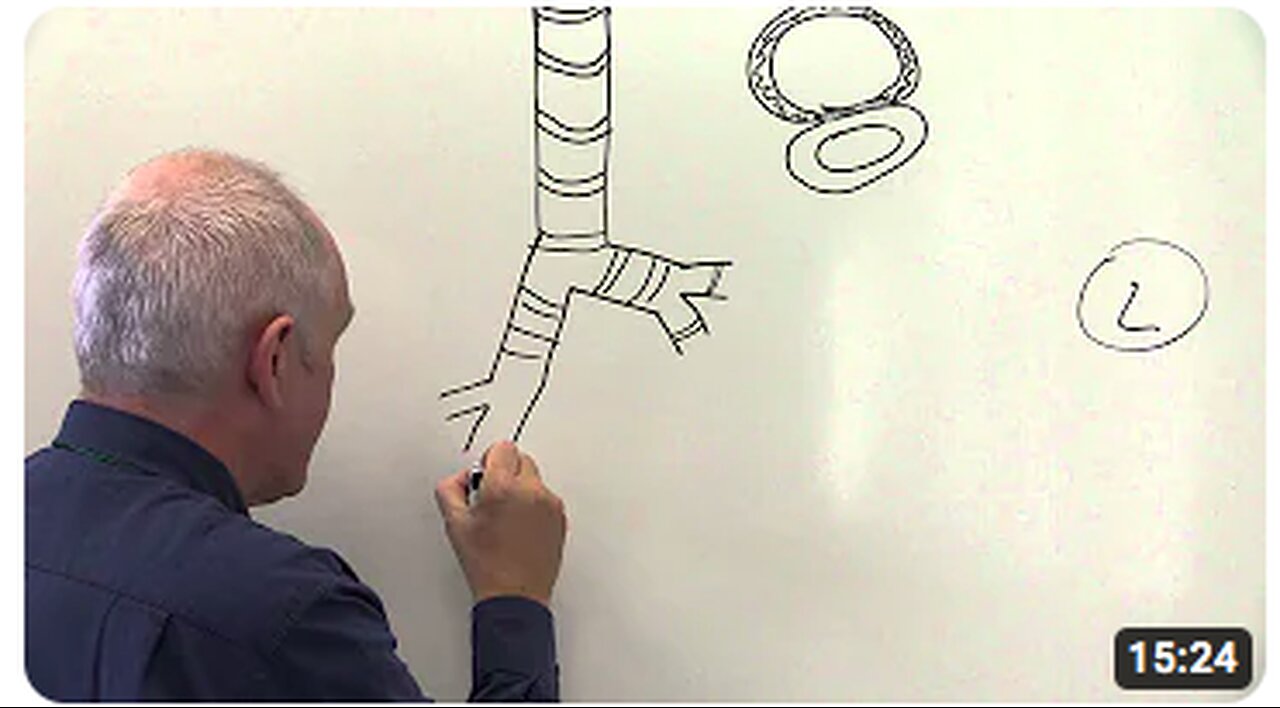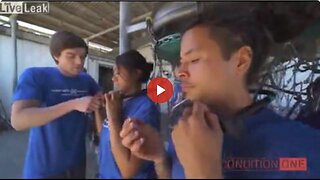Premium Only Content

Respiratory System 2, Breathing and ventilation
Skeletal structures associated with ventilation
The lungs are surrounded with bones which provide protection against damage from outside trauma. Protection from the back is provided by the thoracic vertebral column. The breast bone or sternum is the flat bone in front of the chest. There are twelve pairs of ribs which form a cage like structure around the lungs, the first ten pairs of which are connected to the sternum via costal cartilage (costal means to do with ribs). Of course men and women both have the same number of ribs. In addition to protection the bony structures are also essential to facilitate the mechanical process of breathing.
Muscles associated with ventilation
The diaphragm is a sheet of skeletal muscle which divides the thoracic and abdominal cavities. When the muscle of the diaphragm is at rest the structure is domed upwards. Contraction causes it to flatten downwards. The ribs are joined together by sheets of intercostal muscles which follow the line of the ribs around the chest. These are the muscles you eat if you have barbecue spare ribs. There are two sets of intercostal muscles, the external and internal. The diaphragm and the intercostal muscles are referred to as the primary respiratory muscles. In addition there are some accessory muscles which are attached to the sternum and upper ribs and start to aid the expansion of the thorax during more vigorous respiratory activity.
Inspiration
To facilitate inspiration the diaphragm contracts, causing it to move down and flatten. At the same time the external intercostal muscles pull the rib cage up and out. Both of these movements result in an increase in the volume of the thoracic cavity. Because the volume of the thorax is increased the pressure of air left inside the thorax, in the lungs, is reduced. Gases will always move from areas of high pressure to areas of lower pressure. As there is a pressure reduction in the thorax, air moves in from the outside to equalise the pressures between the atmosphere and the reduced pressure inside the lungs. So in inspiration when air moves into the lungs the process is one of negative pressure ventilation. This is in contrast to artificial ventilation when air is actively blown into the lungs in the process of positive pressure ventilation. The increase in the volume of air in the lungs stretches the elastic tissues and smooth muscle associated with the walls of the bronchioles and alveoli. This is analogous to blowing up a balloon.
Expiration
During expiration, the smooth muscle and elastic tissue in the walls of the bronchioles and alveoli recoil. This reduces the volume of these structures and so increases the pressure of the air they contain. This is analogous to releasing the pressure on the neck of a balloon; as the elastic walls of the balloon recoil the pressure is increased so air is blown out. As a result of these elastic properties the lungs will passively recoil facilitating expiration. This increases the air pressure in the lungs as a whole, and air is blown out.
To assist this process the diaphragm relaxes and so moves up. The external intercostal muscles also relax which allows the ribs to fall down and in. The movement of the diaphragm up, and the ribs down and in, reduces the volume of the thoracic cavity. Because the volume is reduced the pressure will be increased. This means the pressure inside the lungs is now greater than in the external atmosphere so air will be blown out of the lungs. From this it can be seen that, while inspiration is an active muscular process, expiration is a passive
You can support the work of campbellteaching, at no cost whatsoever to yourself, if you use the link below as your bookmark to access Amazon. Thank you.
If in the US use this link http://goo.gl/mDMfj5
If in the UK use this link http://goo.gl/j0htQ5
-
 1:17
1:17
Biological Medicine
14 hours agoVegans chain themselves to poultry processing machine all is well until someone turns on the machine
5282 -
 LIVE
LIVE
Viss
2 hours ago🔴LIVE - The Tactics That Lead To Consistent Wins in PUBG!
73 watching -
 1:31:50
1:31:50
Russell Brand
2 hours ago“I’ll NEVER Be The Same…This SHOCKED Me” Dan Bongino Breaks Silence & Vows to Reveal “TRUTH” - SF621
123K77 -
 1:02:24
1:02:24
Sean Unpaved
2 hours agoGridiron to Diamond: Rookie QBs, Madden 99s, Salary Caps & NIL's Ripple Effect
18.4K -
 25:24
25:24
Scary Mysteries
6 hours agoSTRANGE & SCARY Mysteries of The Month - July 2025
3.44K1 -
 1:02:02
1:02:02
Timcast
3 hours agoTrump BULLIES Europe Into MONSTER Trade Deal, Europe COPING Over Trump MASTERCLASS
134K78 -
 2:07:13
2:07:13
Steven Crowder
5 hours ago🔴Game Over: Trump's EU Trade Victory Shows How Stupid "Experts" Really Are
366K193 -
 20:03
20:03
Neil McCoy-Ward
3 hours agoTHE UK 🇬🇧 JUST ENDED 140 YEARS OF FREE SPEECH! (How Did It Come To THIS?!)
13.2K10 -
 1:56:26
1:56:26
The Charlie Kirk Show
3 hours agoTHE CHARLIE KIRK SHOW IS LIVE 07.28.25
63.1K16 -
 5:39:28
5:39:28
JuicyJohns
6 hours ago🟢#1 REBIRTH PLAYER 10.2+ KD🟢 !loadout
69.7K1